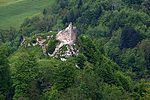Heinrich I. von Hasenburg
Heinrich I von Hasenburg (* 11th century or 12th century; † March 25, 1190 in Strasbourg ) was Prince-Bishop of Strasbourg from 1180 to 1190 under the rule of Emperor Friedrich I , under the pontificate of Alexander III. , Lucius III. , Urban III. and Gregory VIII and Clement III.
Origin and family
Bishop Heinrich comes from the von Hasenburg family. It had its headquarters in Asuel, today a village and a former political municipality in the Porrentruy district of the canton of Jura in Switzerland . The Hasenburg are a sideline of the Burgundian Montfaucon , under which some members became Bishop of Basel or Archbishop of Besançon . Burchardus I of Montfaucon was the father of Hugo, Freiherr von Hasenburg (Baron d'Asuel). Hugo's descendants built the Hasenburg near Willisau , which later became the property of the Neuchâtel dynasty (Maison de Neuchâtel).
Live and act
Heinrich was nicknamed Byllung and was a scholaster at the Strasbourg monastery when he was raised to the bishopric. A contemporary author says of him that he was very well versed in the spiritual and secular sciences and that his Ciceronian suade won hearts .
At the beginning of his episcopate he inaugurated the monastery church of Truttenhausen in honor of the Mother of God and Saint Nicholas, which Herrad von Landsberg , Abbess of Hohenburg , and her stepbrother Günther von Vigenhege, had built from their patrimonial property for regulated Augustinian canons in 1181 . The same abbess moved from the monastery of Étival for the spiritual guidance of the canons of Hohenburg Premonstratensian monks , for whom she had a monastery built in 1182 at the Sankt Gorgonskapelle. In the same year, the episcopal steward Walter Spender built a little church in honor of St. Magdalena, Mauritius and St. Nicholas instead of a small castle above the Breusch . This little church was intended to serve as a family crypt for the members of his family and because its ground floor belonged to the collegiate church of St. Thomas, it became a branch of the Thomas monastery. It later became a parish church under the name of Saint Nicholas.
In 1183 some monks came the priory of Sainte-Marie-des-Champs of Metz with relics to Alsace and settled to Rouffach down. Bishop Heinrich gave them a place on a neighboring hill on which they built the priory of St. Valentine. In June 1183 the learned bishop of Strasbourg was in Constance and had the imperial commissaries who, in the name of Friedrich and his son Heinrich, affirmed the Lombard cities their customs and conventional rights by means of an oath. The year 1187 was fateful for Strasbourg, when a terrible city fire in May consumed more than 160 houses. Bishop Heinrich provided the victims with help, shelter and food for the homeless.
In 1187 the collegiate church of Strasbourg ratified an act of donation of all goods that a noble Alsatian, Walfried von Bischofsheim, had bequeathed to the Baumgarten monastery . He was accepted there as a monk because he was childless.
The famous Saladin , Sultan of Egypt, conquered Jerusalem again on October 2, 1187 and destroyed the Christian kingdom in the east. Pope Gregory VIII immediately had a new crusade preached and sent his legates to Strasbourg, where Frederick I was then resident. Bishop Heinrich supported the legates and through his eloquence he convinced many counts and barons to join the crusade, which was actually only decided in the Reichstag in Mainz on March 25, 1188. Emperor Friedrich I and his son Friedrich , Duke of Swabia and Alsace, took the cross . On April 23, they left Alsace and on May 28, 1188, held an army show over 50,000 men in Pressburg, with whom they marched across Bulgaria against Asia, where they moved before Seleucia after taking the city of Iconium .
Bishop Heinrich had also taken the cross in Mainz. On December 13, 1189, he dedicated a chapel in honor of St. James , which Rudolf, mayor of Strasbourg, had built. Thereupon he followed the army campaign, came to Greece, from where he quickly returned to Strasbourg weak and sick and passed away on Easter Sunday, March 25th, 1190. His body was buried in the St. Andrew's Chapel in the minster.
literature
- Ludwig Gabriel Glöckler: History of the diocese of Strasbourg. Printed by Le Roux, Strasbourg 1879, pp. 210–215.
- Hermann Bloch: Regests of the bishops of Strasbourg. Commission for the publication of the Alsatian historical sources, part 1, The Annals of the Alsatian Staufer Period. Publishing house of the Wagner University and bookstore, Innsbruck 1908.
Individual evidence
- ↑ Bernard Prongué: Asuel. In: Historical Lexicon of Switzerland .
- ^ Ansgar Wildermann: Montfaucon, de. In: Historical Lexicon of Switzerland .
- ^ Franziska Hälg-Steffen: Hasenburg, from. In: Historical Lexicon of Switzerland .
- ^ Glöckler: History of the diocese of Strasbourg. Pp. 210-214.
- ↑ August Potthast: Guide to the historical works of the European Middle Ages from 375-1500. Bibliotheca historica medii aevi, complete table of contents for 'Acta sanctorum' of the Bollandists. Source: Auctor Historiae de Frederici I, asiatica expeditione, 1194.
- ^ Glöckler: History of the diocese of Strasbourg. P. 211.
- ^ Glöckler: History of the diocese of Strasbourg. P. 213.
- ^ Glöckler: History of the diocese of Strasbourg. P. 213.
- ^ Glöckler: History of the diocese of Strasbourg. P. 214.
| personal data | |
|---|---|
| SURNAME | Heinrich I. von Hasenburg |
| ALTERNATIVE NAMES | Byllung |
| BRIEF DESCRIPTION | Bishop of Strasbourg |
| DATE OF BIRTH | 11th century or 12th century |
| PLACE OF BIRTH | Asuel |
| DATE OF DEATH | March 25, 1190 |
| Place of death | Strasbourg |



